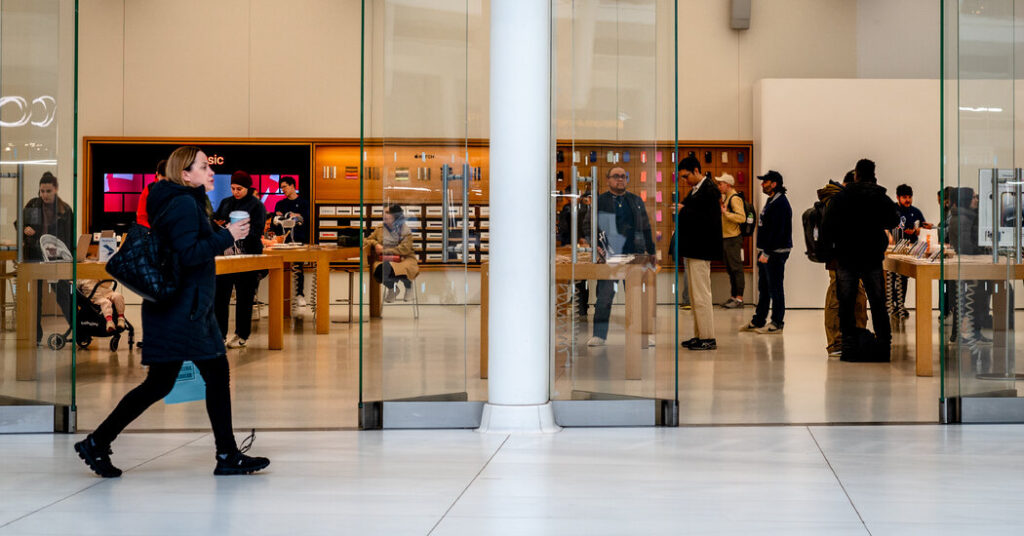On Thursday morning, Tim Cook, Apple’s chief executive, woke up to the worst day for his company’s stock in five years.
Apple shares fell more than 9 percent in response to President Trump’s plan to put steep tariffs on products made abroad. The declines at the world’s most valuable company led a sharp sell-off in tech stocks as the Nasdaq composite index, which is loaded with technology companies, sank nearly 6 percent.
Collectively, the largest tech companies, which have been at the forefront of the U.S. economy over the past decade, lost nearly $1 trillion in the day of trading. The declines at Apple, Nvidia, Microsoft, Meta, Alphabet and Amazon resulted in one of the industry’s worst-performing days since the Covid-19 pandemic turned the global economy upside down.
Instead of “liberation day,” as Mr. Trump branded his tariff news conference, some market observers began calling it “obliteration day.” Richard Kramer, an analyst at Arete Research, said, “Today is an across-the-board disruption of the American economy, so anything with consumer exposure is getting creamed.”
Apple was at the forefront of the tech industry’s drop because it makes almost all of its iPhones, iPads and Macs overseas. The company counts on the sale of those devices for three-quarters of its nearly $400 billion in annual revenue. It will either have to cover the costs of tariffs, cutting into its profits, or pass them on to customers by raising prices, which could reduce the number of devices it sells.
The potential hit to the company’s profits triggered one of its steepest declines in its share price during trading since March 2020, when Apple fell 10 percent as fears of the coronavirus triggered a market sell-off.
Wall Street analysts who follow Apple have been looking for signs that it will be granted a tariff exemption by the White House, as it was when the Trump administration previously introduced tariffs in 2018. But since President Trump’s news conference yesterday, there has been no indication that Apple or any other companies will be spared.
As a result, many analysts have been scrambling to update their forecasts on Apple’s profits.
The investment bank TD Cowen estimates that every 10 percent of tariffs on a product imported from China, India or Vietnam — where Apple does most of its manufacturing — would reduce the company’s profit by more than 3.5 percent. The Wall Street advisory said Apple could offset that profit decline with a 6 percent price increase for every 10 percent of tariff. Given that China is being hit with 54 percent tariffs and that it makes 90 percent of the world’s iPhones, the price of most $1,000 iPhones would then jump to about $1,300.
“This is going to be a cyclone of demand destruction,” Mr. Kramer said. He said that Apple’s plans for manufacturing in 2026 are already set, so it won’t be able to avoid tariffs until 2027, at the earliest. “You cannot re-architect your supply chain in a quarter.”
Apple did not respond to requests for comment.
Apple wasn’t alone in feeling the sting of Mr. Trump’s new tariffs. Amazon sank nearly 9 percent after the Trump administration said it would eliminate a tariff exemption on low-priced products shipped directly to customers from Hong Kong and China. The provision, known as the de minimis exception, allowed e-commerce companies to ship less than $800 in goods without paying taxes on them. Those shipments, while slow by Amazon’s standards, have been seen as a potential growth area of Amazon’s e-commerce sales because they offer such low-cost products.
More broadly, by most estimates a majority of the top marketplace sellers on Amazon are based in China. The tariffs would force them to choose whether to cover the costs of tariffs by taking less profit or passing those costs onto customers through higher prices. The sellers could also pull back on profitable services that Amazon offers, such as advertising.
Shares of Nvidia, the world’s leading artificial intelligence chip maker, sank more than 7 percent as investors evaluated whether companies might be forced to cut back A.I. spending in light of tariffs.
For now, the Trump administration has said that semiconductors will be exempted from tariffs. But it is in the process of evaluating chips for tariffs under a national security provision called Section 232 of the Trade Expansion Act. That is expected to result in tariffs of 10 percent or more on chips made overseas, which would be a blow to an industry that imported an estimated $82 billion in semiconductors last year.
Nvidia also faces the possibility that it and its customers will have to pay tariffs on A.I. supercomputers made overseas. The company’s top-of-the-line server, the Nvidia GB200 NVL72, costs an estimated $3 million. Some of those machines are made in Taiwan, which faces a 32 percent tariff that would increase the cost of the machine by nearly $1 million.
The repercussions rippled through other companies at the forefront of the build out of A.I. servers, including Dell, which sank 19 percent, and Oracle, which fell nearly 6 percent.
Speaking last month at a conference, Jensen Huang, Nvidia’s chief executive, said that tariffs would likely have a short-term affect on the business and added that the company is looking to set up production in the United States.
The bigger fallout for chip makers could come from customers buying fewer of the smartphones, cars and appliances that semiconductors power, said Stacy Rasgon, an analyst with Bernstein Research.
“As PCs and cars and all of these things get more expensive, we’re probably going to buy less of them,” Mr. Rasgon said. “There’s nowhere for businesses to hide.”
Karen Weise contributed reporting.
https://www.nytimes.com/2025/04/03/business/economy/apple-stock-tech-selloff.html


